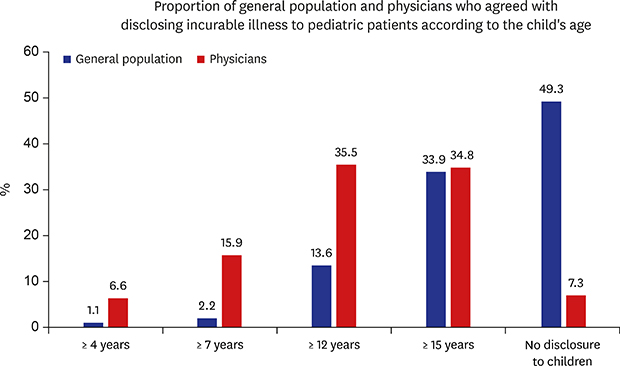1. Weeks JC, Cook EF, O'Day SJ, Peterson LM, Wenger N, Reding D, et al. Relationship between cancer patients' predictions of prognosis and their treatment preferences. JAMA. 1998; 279(21):1709–1714.

2. Fried TR, Bradley EH, Towle VR, Allore H. Understanding the treatment preferences of seriously ill patients. N Engl J Med. 2002; 346(14):1061–1066.

3. Murphy DJ, Burrows D, Santilli S, Kemp AW, Tenner S, Kreling B, et al. The influence of the probability of survival on patients' preferences regarding cardiopulmonary resuscitation. N Engl J Med. 1994; 330(8):545–549.

4. Wright AA, Zhang B, Ray A, Mack JW, Trice E, Balboni T, et al. Associations between end-of-life discussions, patient mental health, medical care near death, and caregiver bereavement adjustment. JAMA. 2008; 300(14):1665–1673.

5. Volandes AE, Paasche-Orlow MK, Mitchell SL, El-Jawahri A, Davis AD, Barry MJ, et al. Randomized controlled trial of a video decision support tool for cardiopulmonary resuscitation decision making in advanced cancer. J Clin Oncol. 2013; 31(3):380–386.

6. Marron JM, Cronin AM, Kang TI, Mack JW. Intended and unintended consequences: ethics, communication, and prognostic disclosure in pediatric oncology. Cancer. 2018; 124(6):1232–1241.

7. Tzuh Tang S, Hung YN, Liu TW, Lin DT, Chen YC, Wu SC, et al. Pediatric end-of-life care for Taiwanese children who died as a result of cancer from 2001 through 2006. J Clin Oncol. 2011; 29(7):890–894.

8. Park JD, Kang HJ, Kim YA, Jo M, Lee ES, Shin HY, et al. Trends in the aggressiveness of end-of-life care for Korean pediatric cancer patients who died in 2007–2010. PLoS One. 2014; 9(6):e99888.

9. Claflin CJ, Barbarin OA. Does “telling” less protect more? Relationships among age, information disclosure, and what children with cancer see and feel. J Pediatr Psychol. 1991; 16(2):169–191.

10. Kreicbergs U, Valdimarsdóttir U, Onelöv E, Henter JI, Steineck G. Talking about death with children who have severe malignant disease. N Engl J Med. 2004; 351(12):1175–1186.

11. Vernick J, Karon M. Who's afraid of death on a leukemia ward? Am J Dis Child. 1965; 109(5):393–397.

12. Mack JW, Wolfe J, Grier HE, Cleary PD, Weeks JC. Communication about prognosis between parents and physicians of children with cancer: parent preferences and the impact of prognostic information. J Clin Oncol. 2006; 24(33):5265–5270.

13. Mack JW, Joffe S. Communicating about prognosis: ethical responsibilities of pediatricians and parents. Pediatrics. 2014; 133:Suppl 1. S24–30.

14. Levy PS, Lemeshow S. Sampling of Populations: Methods and Applications. 5th ed. Hoboken, NJ: John Wiley & Sons;2013.
15. Sisk BA, Bluebond-Langner M, Wiener L, Mack J, Wolfe J. Prognostic disclosures to children: a historical perspective. Pediatrics. 2016; 138(3):e20161278.

16. Nagy M. The child's theories concerning death. J Genet Psychol. 1948; 73(First Half):3–27.

17. Death in childhood. Can Med Assoc J. 1968; 98(20):967–969.
18. Alvarez WC. Care of the dying. J Am Med Assoc. 1952; 150(2):86–91.

19. Yun YH, Kwon YC, Lee MK, Lee WJ, Jung KH, Do YR, et al. Experiences and attitudes of patients with terminal cancer and their family caregivers toward the disclosure of terminal illness. J Clin Oncol. 2010; 28(11):1950–1957.

20. Forbes T, Goeman E, Stark Z, Hynson J, Forrester M. Discussing withdrawing and withholding of life-sustaining medical treatment in a tertiary paediatric hospital: a survey of clinician attitudes and practices. J Paediatr Child Health. 2008; 44(7-8):392–398.

21. Davies B, Sehring SA, Partridge JC, Cooper BA, Hughes A, Philp JC, et al. Barriers to palliative care for children: perceptions of pediatric health care providers. Pediatrics. 2008; 121(2):282–288.

22. Berlinger N, Jennings B, Wolf SM. The Hastings Center Guidelines for Decisions on Life-Sustaining Treatment and Care Near the End of Life. 2nd ed. New York: Oxford University Press;2013.
23. Surbone A. Truth telling to the patient. JAMA. 1992; 268(13):1661–1662.

24. Yun YH, Lee CG, Kim SY, Lee SW, Heo DS, Kim JS, et al. The attitudes of cancer patients and their families toward the disclosure of terminal illness. J Clin Oncol. 2004; 22(2):307–314.

25. Badarau DO, Wangmo T, Ruhe KM, Miron I, Colita A, Dragomir M, et al. Parents' challenges and physicians' tasks in disclosing cancer to children. A qualitative interview study and reflections on professional duties in pediatric oncology. Pediatr Blood Cancer. 2015; 62(12):2177–2182.

26. Bluebond-Langner M, Belasco JB, DeMesquita Wander M. “I want to live, until I don't want to live anymore”: involving children with life-threatening and life-shortening illnesses in decision making about care and treatment. Nurs Clin North Am. 2010; 45(3):329–343.

27. Hilden JM, Watterson J, Chrastek J. Tell the children. J Clin Oncol. 2000; 18(17):3193–3195.

28. Rosenberg AR, Starks H, Unguru Y, Feudtner C, Diekema D. Truth telling in the setting of cultural differences and incurable pediatric illness: a review. JAMA Pediatr. 2017; 171(11):1113–1119.
29. Keam B, Yun YH, Heo DS, Park BW, Cho CH, Kim S, et al. The attitudes of Korean cancer patients, family caregivers, oncologists, and members of the general public toward advance directives. Support Care Cancer. 2013; 21(5):1437–1444.

30. Kim MS, Lim NG, Kim HJ, Kim C, Lee JY. Pediatric deaths attributed to complex chronic conditions over 10 years in Korea: evidence for the need to provide pediatric palliative care. J Korean Med Sci. 2018; 33(1):e1.










 PDF
PDF Citation
Citation Print
Print




 XML Download
XML Download